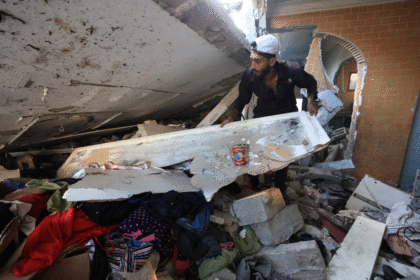Saudi Airlines Flight with 298 Passengers Sparks Panic as Smoke & Fire Detected in Landing Gear at Lucknow Airport
Panic at Lucknow Airport as a Saudi Airlines flight with 298 passengers lands amid smoke and sparks from landing gear. All passengers safe after emergency response
A Saudia Airlines flight from Jeddah sparked a brief scare at Lucknow’s Chaudhary Charan Singh International Airport on Saturday morning after smoke was seen coming from the aircraft’s wheels shortly after landing.
The incident occurred around the arrival of Flight SV 312. The ground staff immediately called in the Airport Rescue and Fire Fighting (ARFF) team, which responded swiftly to the situation. Working in coordination with the Saudi technical crew, the emergency response team managed to contain the smoke before it could cause any damage to the aircraft.
On Sunday, June 15, 2025, a Saudi Airlines flight arriving from Jeddah experienced a significant technical issue upon landing at Lucknow’s Chaudhary Charan Singh International Airport. The aircraft, which was carrying Hajj pilgrims, emitted smoke from its left-side wheels during touchdown, prompting immediate emergency protocols. Fortunately, all 298 passengers and crew members aboard the flight were safely evacuated, and no injuries were reported.

As the aircraft touched down on Runway 27 at approximately 10:30 AM IST, smoke was observed emanating from the left-side landing gear. This unusual occurrence led to swift action from the flight crew and airport authorities. Initial reports suggest that the cause of the smoke was a hydraulic leak, although a comprehensive investigation is underway to confirm the exact nature of the malfunction.
Emergency response teams were promptly deployed to the scene. Fire and rescue units from the airport, along with local emergency services, were on standby to handle any potential escalation. Their preparedness and quick response were instrumental in ensuring the safety of all individuals involved.
Upon landing, the aircraft was immediately taxied to a designated emergency area. Passengers were then safely deplaned using the aircraft’s emergency slides, a standard procedure during such incidents. The airport’s emergency evacuation plan was executed flawlessly, ensuring that all 298 individuals aboard were accounted for and safely escorted to the terminal.
The passengers, many of whom were Hajj pilgrims returning from their religious journey, were understandably shaken but relieved to be safe. Airport officials provided necessary assistance, including medical evaluations and accommodations, while the situation was assessed and resolved.
The aircraft involved in the incident was a Boeing 777-300ER, a long-range wide-body airliner known for its reliability. The specific model, SV-123, had undergone routine maintenance checks prior to departure. The hydraulic system, which plays a crucial role in the operation of the landing gear, is currently the focus of the investigation.
Hydraulic leaks in landing gear systems, though rare, can occur due to various factors such as wear and tear, manufacturing defects, or external damage. In this case, the leak led to the emission of smoke, which was promptly detected by the flight crew and air traffic controllers. Their quick identification and response were vital in preventing a potential disaster.
The Directorate General of Civil Aviation (DGCA), India’s aviation regulatory body, has initiated a formal investigation into the incident. The airline’s maintenance records, the aircraft’s flight data, and the hydraulic system’s components will be thoroughly examined to determine the root cause of the malfunction. Preliminary findings are expected to be released in the coming days.
This incident in Lucknow is reminiscent of a similar occurrence in July 2024, when a Saudi Airlines flight from Riyadh experienced a landing gear fire upon arrival at Peshawar’s Bacha Khan International Airport. In that case, the left-hand side landing gear caught fire during landing, leading to a swift evacuation of all 297 passengers and crew members. The fire was promptly extinguished, and no injuries were reported.
While such incidents are rare, they underscore the importance of rigorous maintenance protocols, timely inspections, and the readiness of emergency response teams. The aviation industry continually strives to enhance safety measures to prevent such occurrences and to ensure the well-being of passengers and crew members.
The presence of Hajj pilgrims aboard the flight added a layer of emotional significance to the incident. The Hajj pilgrimage is one of the five pillars of Islam, and for many, it is a once-in-a-lifetime journey. The pilgrims’ safe return to India was a relief to their families and communities. Local religious leaders expressed gratitude for the safe handling of the situation and offered prayers for the well-being of all involved.
Chaudhary Charan Singh International Airport’s management commended the coordinated efforts of the airline’s crew, airport staff, and emergency services. The airport’s emergency response plan was executed without any hitches, ensuring a swift and safe resolution to the incident.
In light of the incident, the airport authorities have announced plans to conduct a comprehensive review of their emergency protocols and to invest in additional training for staff to handle similar situations in the future. The safety of passengers remains the top priority, and continuous improvements are being made to maintain high safety standards.
The emergency landing of the Saudi Airlines flight in Lucknow serves as a reminder of the complexities and challenges of modern aviation. While the incident posed a significant scare, the swift and effective response by all parties involved ensured that it did not escalate into a tragedy. The safety of passengers and crew members was upheld, and the incident is being thoroughly investigated to prevent future occurrences.
As the investigation progresses, the aviation community remains committed to learning from such incidents and implementing measures to enhance safety and reliability in air travel.








